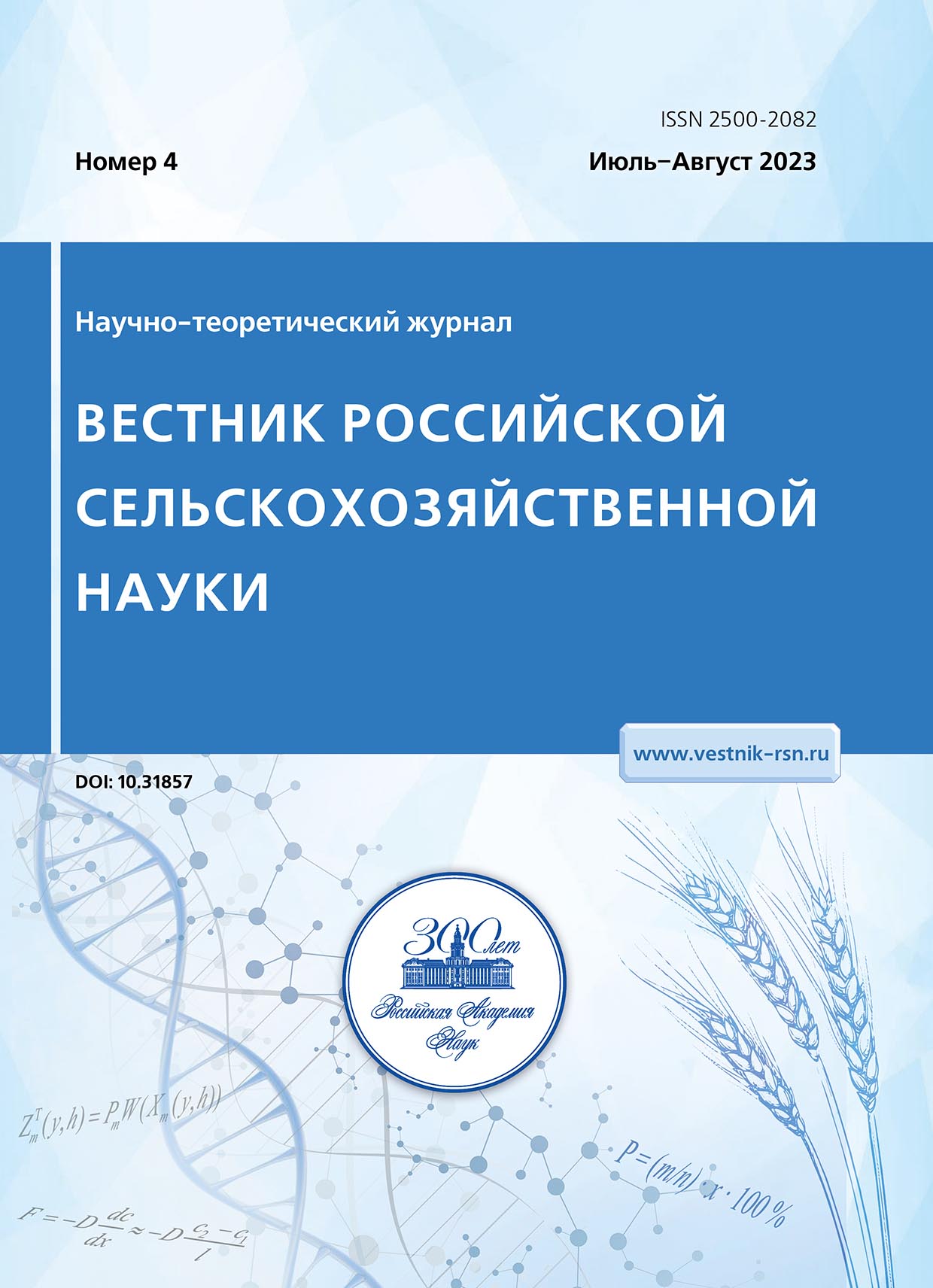ASSESSMENT OF THE PHYTOSANITARY STATE OF AGRICULTURAL SEEDINGS USING AGROBIOTECHNOLOGY
Abstract
The results of weed infestation of cultivated oats and maize by the phases of their development and the manifestation of the signs of oat septoria affection in the experiment with an applied agrobiotechnology, including the use of biological preparations Trichoplant, SK (based on Trichoderma) and Biogor-Zh (based on Lactobacillus), nitrogen fertilizers (at the rate of 10 kg of NPPN per 1 ton of straw) and lime at the rate of 1.5 t/ha when using crushed by-products as fertilizer are presented. The work was carried out in the scientific and production experiment, founded in 2018 and located in Kursk Region, in Medvensky District, settlement of Panino, in two fields. In 2022 in the first field (cereal crop rotation) cultivated oat (Avena sativa L.) of the variety “Borets” was grown with buckwheat as a previous crop, in the second field (cereal and row crop rotation) maize for grain (Zea mays L.) of the variety “Delitop” was cultivated with winter wheat as a previous crop. The results were obtained in the following variants: 1. Control (no fertilizers and afterharvesting residues); 2. Crushed by-products of the crop as a background; 3. Background + nitrogen fertilizers; 4. Background + lime; 5. Background + biopreparations; 6. Background + biopreparations + nitrogen fertilizers; 7. Background + biopreparations + lime. The number of weeds less by 36.7 and 76.4 % related to the control, respectively, was found when biopreparations with nitrogen fertilizers were applied in maize and cultivated oats in the phase of ear emergence. The number of oat plants affected with ceptoria in the variants with biopreparations applied in the tillering phase and with combined application of biopreparations and lime in the phase of ear emergence was by 14.9 and 22.9 % less as compared to the control, respectively.
References
2. Vysockaya E.A., Krekoten' M.A. Optimizaciya bioresursnogo potenciala podsolnechnika s ispol'zovaniem v tekhnologii vozdelyvaniya biologicheski aktivnyh preparatov // Vestnik Voronezhskogo gosudarstvennogo universiteta. 2017. №1. (52). S. 20-26.
3. Zashchepkin E.E., Shutko A.P., Tuturzhans L.V. Zheltaya pyatnistost' kak sostavnaya chast' patogennogo kompleksa ozimoj pshenicy v Central'nom Predkavkaz'e // Sovremennye problemy nauki i obrazovaniya. 2015. №2. S. 828-838.
4. Zykov S.A. Biopreparaty v sovremennom zemledelii // AgroForum. 2019. №3. S. 21-27.
5. Kojshybaev M., Mumindzhakov H. Metodicheskie ukazaniya po monitoringu boleznej, vreditelej i sornyh rastenij na posevah zernovyh kul'tur. Ankara. 2016. 42 s.
6. Mamsirov N.I., Blagopoluchnaya O.A., Mamsirov N.A. Effektivnost' primeneniya biopreparatov pri vozdelyvanii zernovyh kul'tur // Zemledelie. 2014. № 5. S. 24-26.
7. Metody ucheta struktury sornogo komponenta v agrocenozah: uchebnoe posobie / sost.: I.V. Fetyuhin, A.P. Avdeenko, S.S. Avdeenko i dr. Donskoj GAU, 2018. 76 s.
8. Sabirova T.P. Vliyanie biopreparatov na produktivnost' sel'skohozyajstvennyh kul'tur // Vestnik APK Verhnevolzh'ya. 2018. №3 (43). S. 18-22.
9. Sanin S.S. Problemy fitosanitarii Rossii na sovremennom etape // Izvestiya Timiryazevskoj sel'skohozyajstvennoj akademii. 2016. №6. S. 45-53.
10. Syrmolot O.V., Bajdelyuk E.S., Kocheva N.S. Primenenie biopreparatov i stimulyatorov rosta pri vozdelyvanii soi v Primorskom krae// Dostizheniya nauki i tekhniki APK. 2020. T.34. №8. S. 70-74.
11. Toropova E.Yu., Zaharov A.F. Predposevnaya podgotovka semyan yarovoj pshenicy v usloviyah resursosberegayushchih tekhnologij // Zashchita i karantin rastenij. 2017. №3. S. 28-32.
12. Shchuchka R.V. Osobennosti vliyaniya biopreparatov i stimulyatorov rosta i sposoba ih primeneniya na urozhaj i kachestvo semyan soi: monografiya. Elec: Eleckij gosudarstvennyj universitet im. I.A. Bunina, 2016. 90 s.
13. Yamalieva A.M., Apaeva N.N. Rol' biopreparatov v uluchshenii fitosanitarnogo sostoyaniya posevov i povyshenii urozhajnosti zernovyh kul'tur // Vestnik Marijskogo gosudarstvennogo universiteta, seriya «Sel'skohozyajstvennye nauki. Ekonomicheskie nauki». 2020. T. 6. №4. S. 450 – 458.
14. Jurosek P. Tiedemann A. Linking plant disease models to climate change scenarios to project future risks of crop diseases // Journal of Plant Diseases and Protection. 2015. No. 122 (1). P. 3-15.


